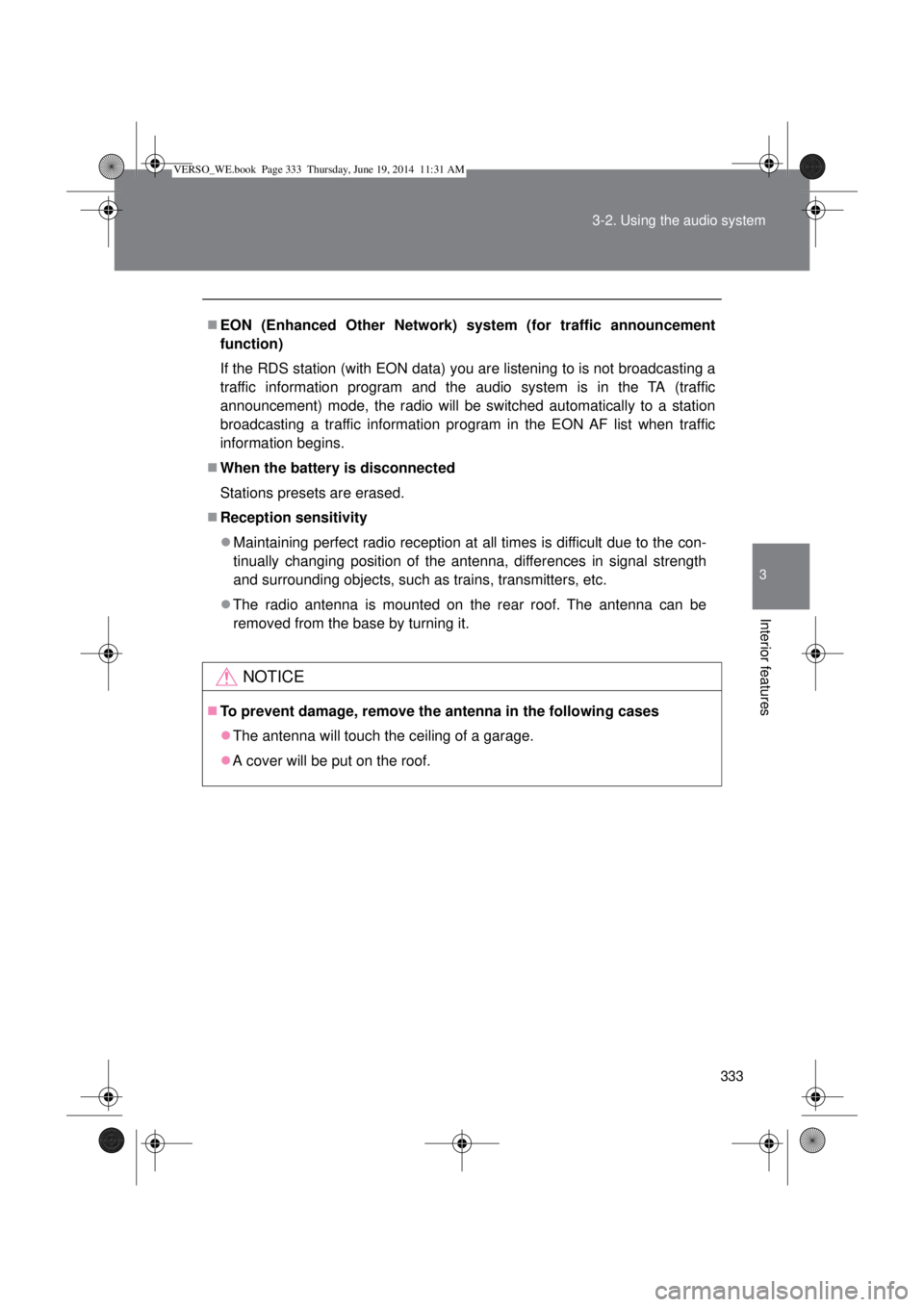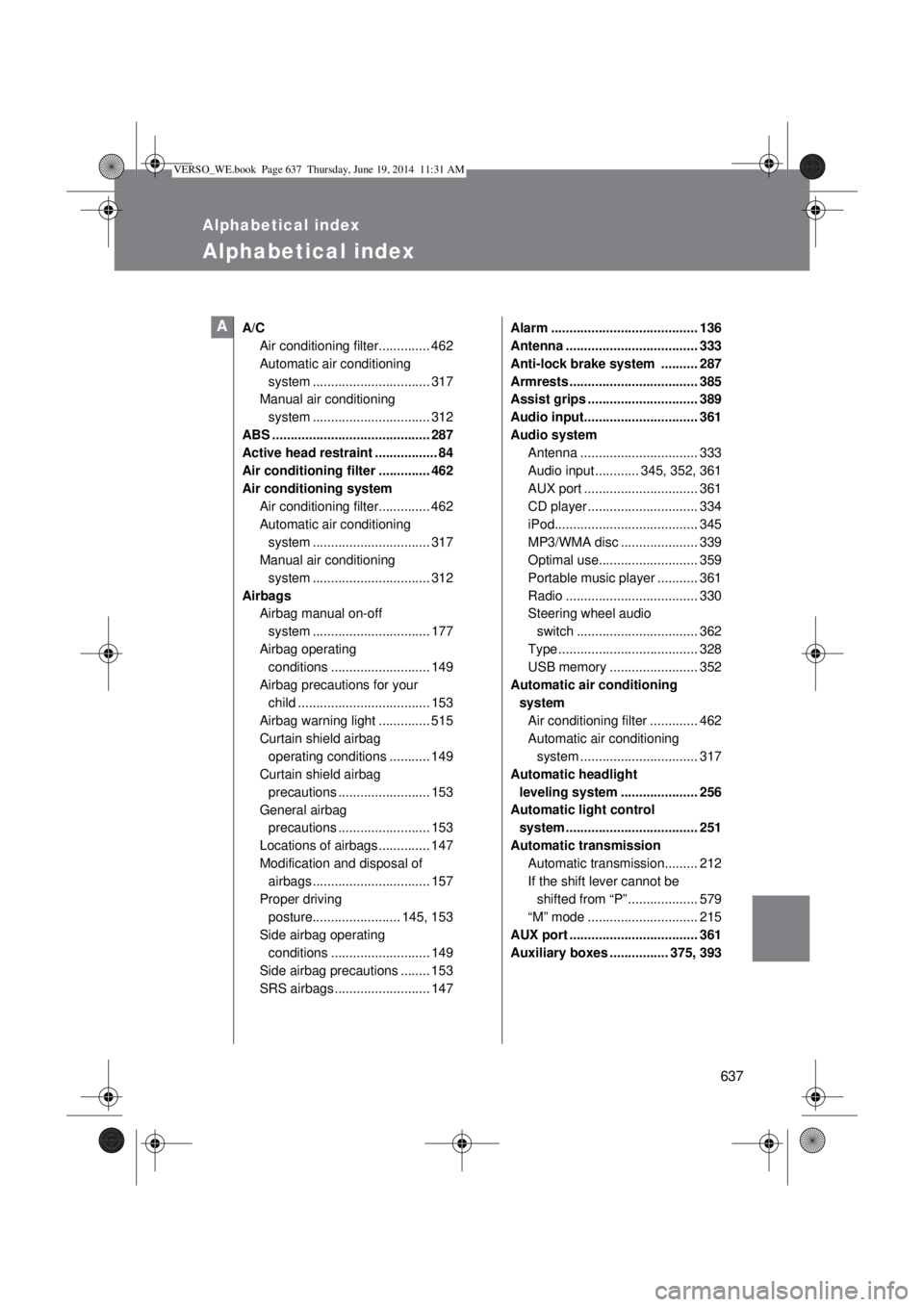2015 TOYOTA VERSO radio antenna
[x] Cancel search: radio antennaPage 48 of 650

48 1-2. Opening, closing and locking the doors
Do not leave the electronic key on top of the instrument panel or near the
door pockets when exiting the vehicle. Depending on the radio wave
reception conditions, it may be detected by the antenna outside the cabin
and the door will become lockable from the outside, possibly trapping the
electronic key inside the vehicle.
Special note for smart entry & start system
When the electronic key is in the operating range, anyone can lock and
unlock the doors even without having the electronic key. However, the
unlocking operation will not be active at a door that has not detected the
electronic key.
When the electronic key is in the operating range and the door handles
get soaked with water due to car washing or heavy rain, the doors may
be locked or unlocked. If the doors are unlocked, the doors will automati-
cally be locked again when no door operations occur in approximately 30
seconds.
If the electronic key is inside or near the vehicle and if the doors are
locked using the wireless remote control, the doors may not be unlocked
with the smart entry & start system. In this case, unlock the doors using
the wireless remote control.
Note for door locking operation
When touching a lock sensor to lock the doors while wearing gloves, the
response may be slow or the doors may not be locked. In this case,
touch the lock sensor without wearing a glove.
When door handles get wet while washing the vehicle with the electronic
key on your person, the doors may be locked and unlocked repeatedly. In
this case, keep the electronic key 2 m (6 ft.) or more away from the vehi-
cle while washing (pay attention to key theft).
When the electronic key is inside the vehicle and door handles get wet
due to a car wash, a warning message stating that the key is in the cabin
may appear on the multi-information display, interior and exterior alarms
may sound. In this case, lock the doors to stop the alarms.
A lock sensor covered with ice, snow or mud may not work properly. In
this case, remove the ice, snow or mud from the lock sensor surface and
then touch the sensor again, or unlock the doors using the lock sensor
located on the lower edge of the door handle.
Fingernails may come into contact with a door when taking hold of a door
handle. Be careful not to damage the door surface or your fingernails.
VERSO_WE.book Page 48 Thursday, June 19, 2014 11:31 AM
Page 62 of 650

62 1-2. Opening, closing and locking the doors
CAUTION
Caution regarding interference with electronic devices
People with implantable cardiac pacemakers, cardiac resynchronization
therapy-pacemakers or implantable cardioverter defibrillators should main-
tain a reasonable distance between themselves and the smart entry &
start system antennas. (P. 44)
The radio waves may affect the operation of such devices. If necessary,
the entry function can be disabled. Ask any authorized Toyota dealer or
repairer, or another duly qualified and equipped professional for details,
such as the frequency of radio waves and timing of the emitted radio
waves. Then, consult your doctor to see if you should disable the entry
function.
Users of any electrical medical device other than implantable cardiac
pacemakers, cardiac resynchronization therapy-pacemakers or implant-
able cardioverter defibrillators should consult the manufacturer of the
device for information about its operation under the influence of radio
waves.
Radio waves could have unexpected effects on the operation of such
medical devices.
Ask any authorized Toyota dealer or repairer, or another duly qualified and
equipped professional for details for disabling the entry function.
VERSO_WE.book Page 62 Thursday, June 19, 2014 11:31 AM
Page 277 of 650

277 2-4. Using other driving systems
2
When driving
Rear corner and rear center sensors:
• The shift lever is in “R”.
Sensor detection information
Certain vehicle conditions and the surrounding environment may affect
the ability of a sensor to correctly detect an obstacle. Particular instances
where this may occur are listed below.
• There is dirt, snow or ice on a sensor.
• A sensor is frozen.
• A sensor is covered in any way.
• The vehicle is leaning considerably to one side.
• On an extremely bumpy road, on an incline, on gravel, or on grass.
• The vicinity of the vehicle is noisy due to vehicle horns, motorcycle
engines, air brakes of large vehicles, or other loud noises producing
ultrasonic waves.
• There is another vehicle equipped with parking assist sensors in the
vicinity.
• A sensor is coated with a sheet of spray or heavy rain.
• The vehicle is equipped with a fender pole or radio antenna.
• Towing eyelet is installed.
• A bumper or sensor receives a strong impact.
• The vehicle is approaching a tall or right-angled curb.
• In harsh sunlight or intense cold weather.
• A non-genuine Toyota suspension (lowered suspension etc.) is
installed.
In addition to the examples above, there are instances in which, because of
their shape, signs and other objects may be judged by a sensor to be closer
than they are.
The shape of the obstacle may prevent a sensor from detecting it. Pay
particular attention to the following obstacles:
• Wires, fences, ropes, etc.
• Cotton, snow and other materials that absorb sound waves
• Sharply-angles objects
• Low obstacles
• Tall obstacles with upper sections projecting outwards in the direction
of your vehicle
VERSO_WE.book Page 277 Thursday, June 19, 2014 11:31 AM
Page 333 of 650

333 3-2. Using the audio system
3
Interior features
EON (Enhanced Other Network) system (for traffic announcement
function)
If the RDS station (with EON data) you are listening to is not broadcasting a
traffic information program and the audio system is in the TA (traffic
announcement) mode, the radio will be switched automatically to a station
broadcasting a traffic information program in the EON AF list when traffic
information begins.
When the battery is disconnected
Stations presets are erased.
Reception sensitivity
Maintaining perfect radio reception at all times is difficult due to the con-
tinually changing position of the antenna, differences in signal strength
and surrounding objects, such as trains, transmitters, etc.
The radio antenna is mounted on the rear roof. The antenna can be
removed from the base by turning it.
NOTICE
To prevent damage, remove the antenna in the following cases
The antenna will touch the ceiling of a garage.
A cover will be put on the roof.
VERSO_WE.book Page 333 Thursday, June 19, 2014 11:31 AM
Page 637 of 650

637
Alphabetical index
Alphabetical index
A/C
Air conditioning filter.............. 462
Automatic air conditioning
system ................................ 317
Manual air conditioning
system ................................ 312
ABS ........................................... 287
Active head restraint ................. 84
Air conditioning filter .............. 462
Air conditioning system
Air conditioning filter.............. 462
Automatic air conditioning
system ................................ 317
Manual air conditioning
system ................................ 312
Airbags
Airbag manual on-off
system ................................ 177
Airbag operating
conditions ........................... 149
Airbag precautions for your
child .................................... 153
Airbag warning light .............. 515
Curtain shield airbag
operating conditions ........... 149
Curtain shield airbag
precautions ......................... 153
General airbag
precautions ......................... 153
Locations of airbags .............. 147
Modification and disposal of
airbags ................................ 157
Proper driving
posture........................ 145, 153
Side airbag operating
conditions ........................... 149
Side airbag precautions ........ 153
SRS airbags .......................... 147Alarm ........................................ 136
Antenna .................................... 333
Anti-lock brake system .......... 287
Armrests ................................... 385
Assist grips .............................. 389
Audio input............................... 361
Audio system
Antenna ................................ 333
Audio input ............ 345, 352, 361
AUX port ............................... 361
CD player .............................. 334
iPod....................................... 345
MP3/WMA disc ..................... 339
Optimal use........................... 359
Portable music player ........... 361
Radio .................................... 330
Steering wheel audio
switch ................................. 362
Type ...................................... 328
USB memory ........................ 352
Automatic air conditioning
system
Air conditioning filter ............. 462
Automatic air conditioning
system ................................ 317
Automatic headlight
leveling system ..................... 256
Automatic light control
system .................................... 251
Automatic transmission
Automatic transmission......... 212
If the shift lever cannot be
shifted from “P” ................... 579
“M” mode .............................. 215
AUX port ................................... 361
Auxiliary boxes ................ 375, 393A
VERSO_WE.book Page 637 Thursday, June 19, 2014 11:31 AM